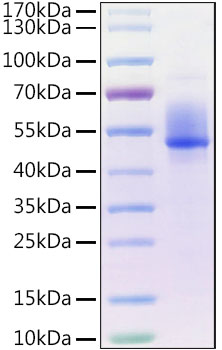Description
Recombinant Human HSP60 Protein
The Recombinant Human HSP60 Protein is a biologically active recombinant protein that plays a significant role in various cellular processes and signaling pathways in human biology. This protein is widely employed in immunological research, cell biology studies, protein-protein interaction analyses, and therapeutic development, providing researchers with a reliable tool for investigating HSP60 function and its implications in health and disease.
This product (SKU: RPCB1901) is produced using E. coli and features a N-GST&His tag for convenient detection and purification. The protein exhibits a calculated molecular weight of 88.7 kDa with an observed molecular weight of 52-65 kDa under denaturing conditions, achieving ≥ 90 % as determined by SDS-PAGE., ensuring exceptional quality and consistency for research applications.
Key Features
| High Purity by Affinity Chromatography | |
| Mammalian & Bacterial Expression Systems | |
| High lot-to-lot consistency via strict QC |
| Product Name: | Recombinant Human HSP60 Protein |
| SKU: | RPCB1901 |
| Size: | 100 μg |
| Reactivity: | Human |
| Synonyms: | HLD4, CPN60, GROEL, HSP60, HSP65, SPG13, HSP-60, HuCHA60 |
| Tag: | N-GST&His |
| Expression Host: | E. coli |
| Calculated MW: | 88.7 kDa |
| Observed MW: | 52-65 kDa |
| Gene ID: | 3329 |
| Protein Description: | High quality, high purity and low endotoxin recombinant Recombinant Human HSP60 Protein (RPCB1901), tested reactivity in E. coli and has been validated in SDS-PAGE.100% guaranteed. |
| Endotoxin: | Please contact us for more information. |
| Purity: | ≥ 90 % as determined by SDS-PAGE. |
| Formulation: | Lyophilized from a 0.22 μm filtered solution of PBS, pH 7.4. |
| Reconstitution: | Centrifuge the vial before opening. Reconstitute to a concentration of 0.1-0.5 mg/mL in sterile distilled water. Avoid vortex or vigorously pipetting the protein. For long term storage, it is recommended to add a carrier protein or stablizer (e.g. 0.1% BSA, 5% HSA, 10% FBS or 5% Trehalose), and aliquot the reconstituted protein solution to minimize free-thaw cycles. |
| Storage: | Store at -20℃.Store the lyophilized protein at -20℃ to -80 ℃ up to 1 year from the date of receipt. After reconstitution, the protein solution is stable at -20℃ for 3 months, at 2-8℃ for up to 1 week. |
HSPD1, also known as HSP60, is a member of the chaperonin family. HSPD1 may function as a signaling molecule in the innate immune system. This protein is essential for the folding and assembly of newly imported proteins in the mitochondria. It may also prevent misfolding and promote the refolding and proper assembly of unfolded polypeptides generated under stress conditions in the mitochondrial matrix. HSPD1 gene is adjacent to a related family member and the region between the 2 genes functions as a bidirectional promoter. Several pseudogenes have been associated with this gene. Mutations associated with this gene cause autosomal recessive spastic paraplegia 13. Defects in HSPD1 are a cause of spastic paraplegia autosomal dominant type 13 (SPG13). Spastic paraplegia is a degenerative spinal cord disorder characterized by a slow, gradual, progressive weakness and spasticity of the lower limbs. Defects in HSPD1 are the cause of leukodystrophy hypomyelinating type 4 (HLD4); also called mitochondrial HSP60 chaperonopathy or MitCHAP-60 disease. HLD4 is a severe autosomal recessive hypomyelinating leukodystrophy. HSPD1 is clinically characterized by infantile-onset rotary nystagmus, progressive spastic paraplegia, neurologic regression, motor impairment, profound mental retardation. Death usually occurs within the first two decades of life.







